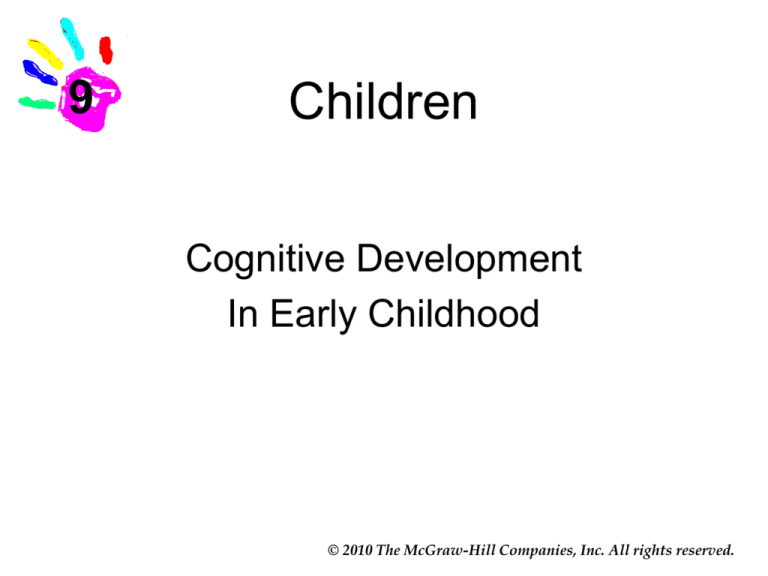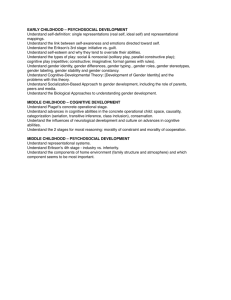
9
Children
Cognitive Development
In Early Childhood
© 2010 The McGraw-Hill Companies, Inc. All rights reserved.
Three Views of Cognitive Changes in Early Childhood
Piaget’s Preoperational Stage
• Operations: internalized set of actions
• Preoperational stage
–
–
–
–
–
Ages 2 to 7
Stable concepts formed
Mental reasoning, magical beliefs emerge
Cannot reverse mental actions
Contains 2 substages: symbolic function and
intuitive
© 2010 The McGraw-Hill Companies, Inc. All rights reserved.
Three Views of Cognitive Changes in Early Childhood
Piaget’s Preoperational Stage
• Symbolic Function Stage
• First substage of preoperational thought
– Occurs in ages 2 to 4, imaginative drawings
– Ability to mentally represent object not present
– Thoughts limited by beliefs:
• Egocentrism: inability to distinguish own
perspectives from those of others
• Animism: inanimate objects are life-like
© 2010 The McGraw-Hill Companies, Inc. All rights reserved.
The Three Mountains Task
View 1
View 2
(d)
(c)
Child
seated here
(d)
(b)
(a)
(a)
(c)
(b)
Child seated here
© 2010 The McGraw-Hill Companies, Inc. All rights reserved.
The Symbolic Drawings of Young Children
(a) 3½-year-old’s “a
pelican kissing a seal”
(b) 11-year-old’s drawing, which is
more realistic and less inventive
© 2010 The McGraw-Hill Companies, Inc. All rights reserved.
Three Views of Cognitive Changes in Early Childhood
Piaget’s Preoperational Stage
• Intuitive Thought Substage
– Uses primitive reasoning, seeks answers to all
• Occurs about 4 to 7 years of age
– Limits in preoperational thought:
• Centration: focusing attention on one
characteristic to the exclusion of all others
• Conservation: realizes altering object’s
substance does not change it quantitatively
© 2010 The McGraw-Hill Companies, Inc. All rights reserved.
Piaget’s Conservation Task
A
B
(a)
C
A
B
C
(b)
© 2010 The McGraw-Hill Companies, Inc. All rights reserved.
Three Views of Cognitive Changes in Early Childhood
Vygotsky’s Theory
• Social constructionist approach
– Focuses on cognitive development
– Children: active construction of knowledge and
understanding by actions and interactions
• Depends on tools used by society
• Shaped by cultural context
© 2010 The McGraw-Hill Companies, Inc. All rights reserved.
Three Views of Cognitive Changes in Early Childhood
Vygotsky’s Theory
• The Zone of Proximal Development (ZPD)
– Lower limit: what child achieves independently
– Upper limit: what can be achieved with
assistance of able instructor
– Cognitive skills in process of maturing
– Scaffolding: changing level of support over
course of teaching session to fit child’s current
performance level
© 2010 The McGraw-Hill Companies, Inc. All rights reserved.
Three Views of Cognitive Changes in Early Childhood
Vygotsky’s Theory
• Language and Thought
– Children’s language uses solving tasks and
social communication
• Plans, monitors, guides behavior
• Private speech: self-regulation
– All mental functions have external, social origins
– Ages 3-7: external to internal speech transition
• Internalized egocentric speech is thoughts
© 2010 The McGraw-Hill Companies, Inc. All rights reserved.
Three Views of Cognitive Changes in Early Childhood
Vygotsky’s Theory
• Teaching Strategies
–
–
–
–
–
Assess and use child’s ZPD in teaching
Use more-skilled peers as teachers
Monitor and encourage private speech use
Place instruction in meaningful context
Transform classroom with Vygotsky’s ideas
• Tools of the Mind
– Visitor presentations, field trips, ‘theme’
activities, journal and story writing, reading
© 2010 The McGraw-Hill Companies, Inc. All rights reserved.
Three Views of Cognitive Changes in Early Childhood
Vygotsky’s Theory
• Evaluating the theory:
–
–
–
–
–
Inner speech important to development
Social interaction affects learning/knowledge
Extends ‘endpoint’ of cognitive development
Teachers serve as facilitators, Piaget agrees
Criticisms:
• Age-related changes not specific enough
• Over-emphasized role of language
• Socioemotional-cognitive link needs more
© 2010 The McGraw-Hill Companies, Inc. All rights reserved.
Three Views of Cognitive Changes in Early Childhood
Information Processing
• Explores how child processes information
– Limitations and advances on:
• Ability to focus attention
• Develop strategies and store memories
• Understand mental processes of self, others
© 2010 The McGraw-Hill Companies, Inc. All rights reserved.
Three Views of Cognitive Changes in Early Childhood
Information Processing
• Attention
– Focusing of cognitive resources
– Visual attention dramatically increases during
preschool years; still has deficits
• Executive attention:
– Action planning, focus on goals, detects errors,
deals with novel or difficult circumstances
• Sustained attention:
– Focused, extended engagement with object,
task, event, etc.
© 2010 The McGraw-Hill Companies, Inc. All rights reserved.
The Planfulness of Attention
J
J
(a)
In 3 pairs of houses, all
windows were identical
(b)
In 3 pairs of houses, the
windows were different
By filming the reflection in children’s eyes, one could
determine what they looked at, how long they looked,
and the sequence of their eye movements.
© 2010 The McGraw-Hill Companies, Inc. All rights reserved.
Three Views of Cognitive Changes in Early Childhood
Information Processing
• Memory
– Retention of information over time
– Implicit memory
– Explicit memory comes in many forms
• Short-term: retained up to 30 seconds
– Greatest increase during early childhood
• Long term: unlimited
– Varies among individuals, affected by age and
experiences
© 2010 The McGraw-Hill Companies, Inc. All rights reserved.
Developmental Changes in Memory Span
8
Digit Span
7
In one study:
memory span
increased from 3
digits at age 2 to
5 digits at age 7
6
5
4
3
2
1
0
2
4
6
8
10 12
Adults
Age (years)
© 2010 The McGraw-Hill Companies, Inc. All rights reserved.
Three Views of Cognitive Changes in Early Childhood
Information Processing
• Accuracy of children’s long-term memories
–
–
–
–
–
Usually increases with age
Memory improves with cues and prompts
Age differences in suggestion susceptibility
Individual differences in susceptibility
Interviewing techniques can distort reports
even when absence of motivation to falsify
(false memories)
– Many factors affect reliability of eyewitness
testimony
© 2010 The McGraw-Hill Companies, Inc. All rights reserved.
Three Views of Cognitive Changes in Early Childhood
Information Processing
• Strategies and Problem Solving
– Strategies: deliberate mental activities to
improve processing information
– Toddlers can learn a strategy
– Early childhood: stimulus-driven changes to
goal-directed problem solving
– Some cognitive inflexibility in ages 3 to 4 due
to lack of understanding
© 2010 The McGraw-Hill Companies, Inc. All rights reserved.
Three Views of Cognitive Changes in Early Childhood
Information Processing
• The Child’s Theory of Mind
– Awareness of mental processes of self, others
– Ages 18 months to 3 years, child understands
three mental states are related to behavior
• Perceptions
• Emotions
• Desires
– Ages 3-5: realizes there are ‘false beliefs’
– Ages 5-7: deeper appreciation of mind itself
© 2010 The McGraw-Hill Companies, Inc. All rights reserved.
Three Views of Cognitive Changes in Early Childhood
Information Processing
• The Child’s Theory of Mind
–
–
–
–
Ages 5-6: knows different experiences exist
Age 7: realizes knowledge is subjective
Theory focuses on preschool years to age 7
Individual differences include: number of
siblings, disabilities, parental interactions
– Executive function: flexible future-oriented
• Important developments occur after age 7
© 2010 The McGraw-Hill Companies, Inc. All rights reserved.
How Young Children Develop Language
Information Processing
• Theory of Mind and Autism
• Autism: in 2-6 of every 1,000 children
– Linked to genetic and brain abnormalities
(impairment ranges from severe to mild)
– Difficulty in social interactions and developing
theory of mind affected by:
• Inability to focus
• Some general intellectual impairment
– Some areas of brain may be above normal
© 2010 The McGraw-Hill Companies, Inc. All rights reserved.
How Young Children Develop Language
Understanding
Phonology and Morphology
• Preschool years:
– Increased sensitivity to spoken sounds and
ability to produce sounds of their language
• Vowels, consonants (simple, complex)
• Notice rhymes, poems, silly names
– Knows morphological rules
– Learn and use rules of syntax
• Vocabulary development is dramatic
• By 1st grade: knows 14,000 words
© 2010 The McGraw-Hill Companies, Inc. All rights reserved.
How Young Children Develop Language
Advances in Pragmatics
• Age, maturity improve language skills
– Better conversationalists
– Engage in extended discourse
• Learn culturally-specific rules, behaviors
• Talk more about events in time, absent
objects and persons
– Ability to change speech style to fit situation
develops by age 4-5; more polite and formal
© 2010 The McGraw-Hill Companies, Inc. All rights reserved.
How Young Children Develop Language
Young Children’s Literacy
• Re-examining early education in U.S.
– Concerns about abilities to read and write
– Supportive environment needed earlier
– Precursors to literacy and academic success:
• Language skills
• Phonological and syntactic knowledge
• Letter identification
• Conceptual knowledge about print
• Conventions and functions of print
© 2010 The McGraw-Hill Companies, Inc. All rights reserved.
Important Features of Young Children’s Education
Variations in Early Childhood Education
• 38 states publicly fund preschool programs
– Child-centered Kindergarten
• Educate the whole child
• Instruction: interests, needs, learning style
• Stress how learned; not what is learned
• Play is important, various activities used
© 2010 The McGraw-Hill Companies, Inc. All rights reserved.
Important Features of Young Children’s Education
Variations in Early Childhood Education
• Preschool programs
– Montessori approach
• Considerable freedom and spontaneity
• Encourage decisions, teacher as facilitator
• Self-regulated, independent problem solving
• Effective time management, responsibility
– Criticisms:
• Deemphasizes verbal interaction, neglects
social development, restricts imagination
© 2010 The McGraw-Hill Companies, Inc. All rights reserved.
Important Features of Young Children’s Education
Variations in Early Childhood Education
• Developmentally appropriate education
– Children
• Learn best from active, hands-on teaching
• Need individual differences considered
• Need socioemotional development
• Developmentally inappropriate education
• Rely on abstract paper-and-pencil activities
• Extensive use of rote drills, seatwork, tests
© 2010 The McGraw-Hill Companies, Inc. All rights reserved.
Important Features of Young Children’s Education
Literacy and Early Childhood Education
• Reading and Writing
– Children should experience feelings of success
and pride in early reading and writing exercises
– Early efforts should be encouraged
– Children need models to emulate
• Math
– Early childhood educators need to introduce
mathematical concepts, methods, and
language
– Special concerns for low-SES children
© 2010 The McGraw-Hill Companies, Inc. All rights reserved.
Important Features of Young Children’s Education
Educating Young Children
Who Are Disadvantaged
• 1965: U.S. tries to break cycle of poverty
– Project Head Start
• To provide opportunity for children from lowincome families to acquire experiences,
skills important for school success
• Not all programs are created equal
• Most provide quality childhood education
© 2010 The McGraw-Hill Companies, Inc. All rights reserved.
Important Features of Young Children’s Education
Controversies in
Early Childhood Education
• Curriculum controversies
– What to teach, how to teach it, who needs it
– Is preschool education necessary for all?
• Should there be ‘universal’ preschool
quality?
– Does preschool matter?
• Home environments and parents vary
– What is required for school readiness?
• Reforms continue, inadequacies recognized
© 2010 The McGraw-Hill Companies, Inc. All rights reserved.
Important Features of Young Children’s Education
Controversies in
Early Childhood Education
• Caregiver activities necessary in earliest
years to ensure ‘readiness’ for school
–
–
–
–
Encourage exploration, mentor in basic skills
Celebrate developmental advances
Research and extend new skills
Protect from inappropriate disapproval, testing,
and punishment, guide and limit behavior
• Some parents ‘hold children back’ from
entering school for an additional year
© 2010 The McGraw-Hill Companies, Inc. All rights reserved.
Important Features of Young Children’s Education
Diversity in Children’s Development
• Japan:
– Preschools: little emphasis on academics
• Experience being a member of the group
– Kindergartens have specific aims
• Identical uniforms and caps worn
• Classrooms: identical in equipment
• In large cities: kindergartens tied to
universities
• Outside U.S.: children given fewer choices
© 2010 The McGraw-Hill Companies, Inc. All rights reserved.
9
The End
© 2010 The McGraw-Hill Companies, Inc. All rights reserved.







